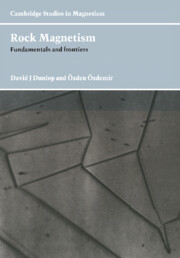Book contents
- Frontmatter
- Contents
- Preface
- Chapter 1 Magnetism in nature
- Chapter 2 Fundamentals of magnetism
- Chapter 3 Terrestrial magnetic minerals
- Chapter 4 Magnetostatic fields and energies
- Chapter 5 Elementary domain structures and hysteresis
- Chapter 6 Domain observations
- Chapter 7 Micromagnetic calculations
- Chapter 8 Single-domain thermoremanent magnetization
- Chapter 9 Multidomain thermoremanent magnetization
- Chapter 10 Viscous and thermoviscous magnetization
- Chapter 11 Isothermal magnetization and demagnetization
- Chapter 12 Pseudo-single-domain remanence
- Chapter 13 Crystallization remanent magnetization
- Chapter 14 Magnetism of igneous rocks and baked materials
- Chapter 15 Magnetism of sediments and sedimentary rocks
- Chapter 16 Magnetism of metamorphic rocks
- Chapter 17 Magnetism of extraterrestrial rocks
- References
- Index
Chapter 17 - Magnetism of extraterrestrial rocks
Published online by Cambridge University Press: 06 July 2010
- Frontmatter
- Contents
- Preface
- Chapter 1 Magnetism in nature
- Chapter 2 Fundamentals of magnetism
- Chapter 3 Terrestrial magnetic minerals
- Chapter 4 Magnetostatic fields and energies
- Chapter 5 Elementary domain structures and hysteresis
- Chapter 6 Domain observations
- Chapter 7 Micromagnetic calculations
- Chapter 8 Single-domain thermoremanent magnetization
- Chapter 9 Multidomain thermoremanent magnetization
- Chapter 10 Viscous and thermoviscous magnetization
- Chapter 11 Isothermal magnetization and demagnetization
- Chapter 12 Pseudo-single-domain remanence
- Chapter 13 Crystallization remanent magnetization
- Chapter 14 Magnetism of igneous rocks and baked materials
- Chapter 15 Magnetism of sediments and sedimentary rocks
- Chapter 16 Magnetism of metamorphic rocks
- Chapter 17 Magnetism of extraterrestrial rocks
- References
- Index
Summary
Introduction
Extraterrestrial rocks formed in quite different environments from those on earth. In practically all cases, oxygen fugacity was very low during crystallization and later shock or thermal metamorphism. Iron-nickel alloys, rather than iron–titanium oxides, are the principal magnetic minerals.
Erosion and sedimentation occur to a very limited extent on the other terrestrial planets and their satellites. Lack of a shielding atmosphere has favoured another secondary process, bombardment of surface rocks by meteorites, principally 4000 to 3300 Ma ago.
The global fields of Mercury, Venus and the moon are orders of magnitude less than the present earth's field. The moon does have magnetic anomalies of regional extent, bearing witness to underlying magnetized crust, but none have a lineated or other regular pattern that would suggest plate tectonic processes. Except on Venus (Solomon et al., 1992), there is no surface evidence for vertical or horizontal tectonic movements except those related to volcanism or meteorite impacts.
Of course, crustal spreading from centres of igneous activity on the moon might not leave the distinctive magnetic signature it does on earth. There is no compelling evidence that the moon ever possessed a substantial global field, although comparatively strong fields must have existed locally to produce the observed anomalies, and no evidence at all for reversal of either global or local fields. If a global field existed, it may not have been dipolar. For these reasons, it is doubtful whether paleodirectional and linear magnetic anomaly studies of the terrestrial variety would be successful on the moon, even if conditions permitted such studies.
- Type
- Chapter
- Information
- Rock MagnetismFundamentals and Frontiers, pp. 503 - 526Publisher: Cambridge University PressPrint publication year: 1997



